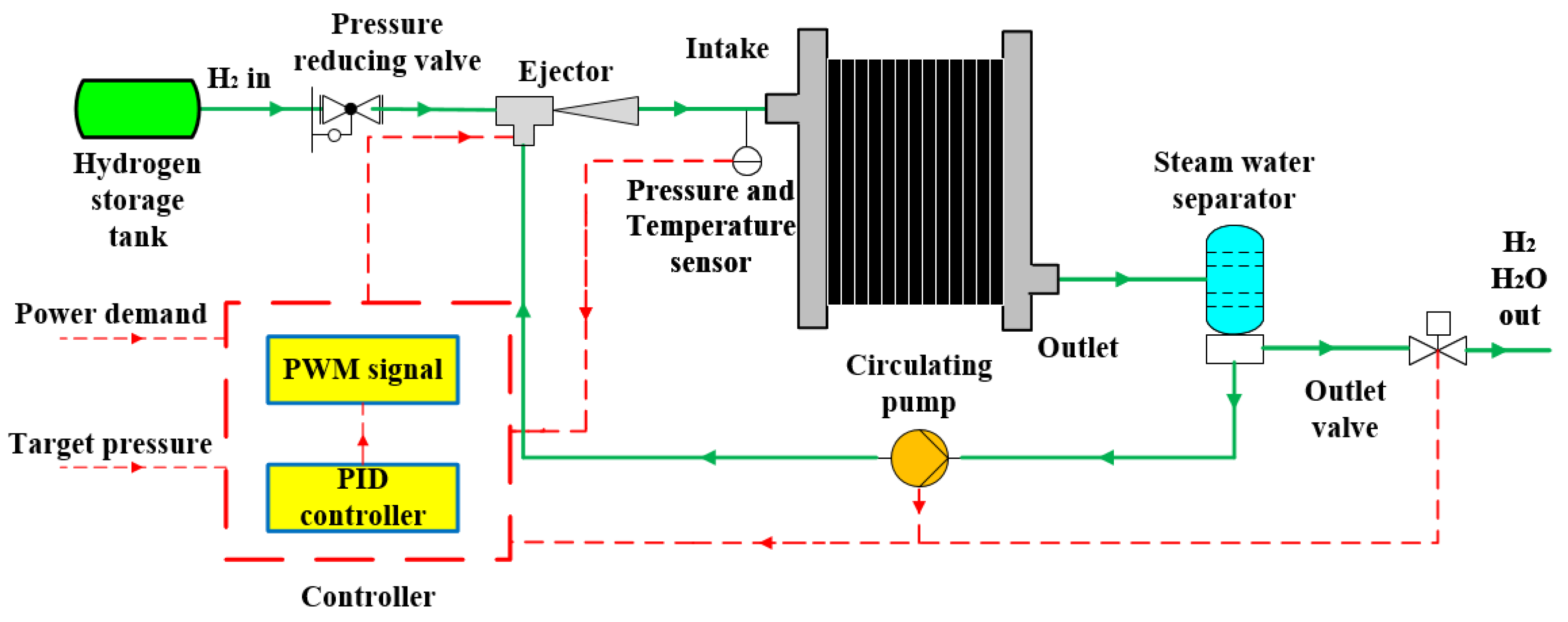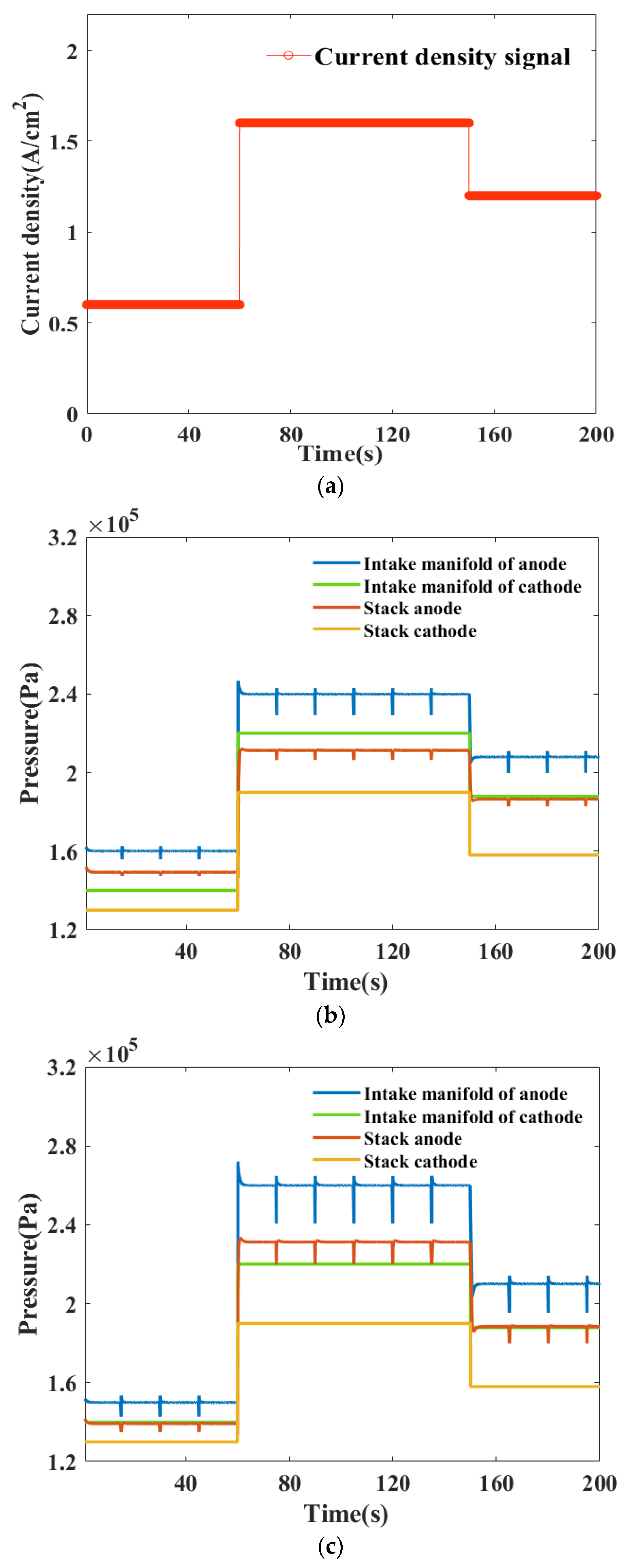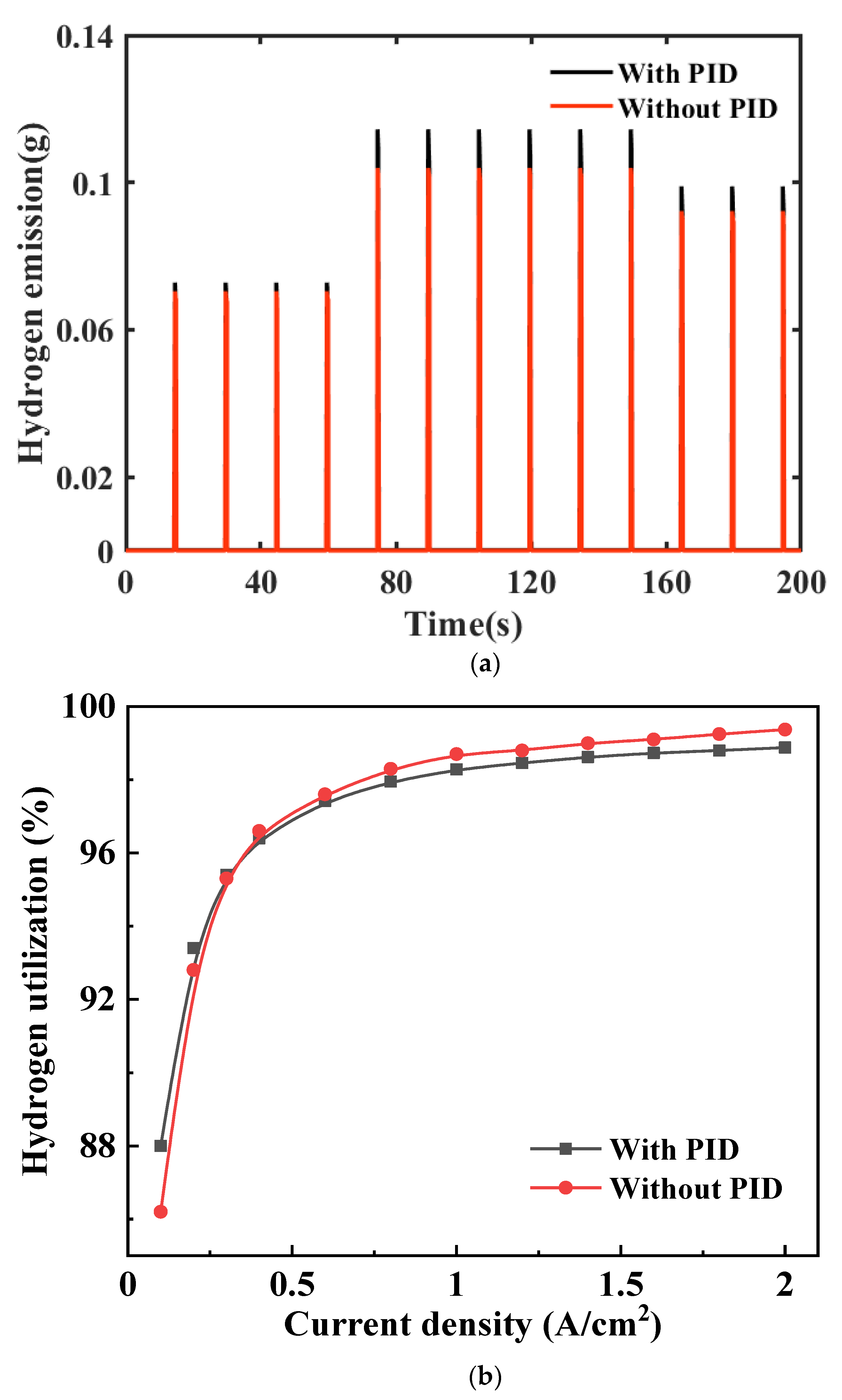Numerical Simulation on Pressure Dynamic Response Characteristics of Hydrogen Systems for Fuel Cell Vehicles
Abstract
:1. Introduction
2. Mathematical Model
2.1. Hydrogen System Model
2.2. Model Assumption
2.3. Fuel Cell Model
2.3.1. Nernst Potential
2.3.2. Activation Overpotential
2.3.3. Ohmic Overpotential
2.3.4. Concentration Overpotential
2.4. Hydrogen System Model
2.4.1. Valve Model
2.4.2. Intake Manifold
2.4.3. Anode Flow Field Model
2.4.4. Outlet Manifold
2.4.5. Pulse Width Modulation Signal
2.5. Pressure Control Objectives
2.6. Simulation Approach
2.7. Model Validation
3. Results and Discussion
3.1. Pressure Dynamic Response Characteristics
3.2. Comparison of Control Strategies
3.3. Output Performance
3.4. Hydrogen Utilization
3.5. Control Strategy Optimization
4. Conclusions
- (1)
- The mathematical model of the hydrogen system was established and connected in series with the fuel cell model. The accuracy of the model was verified by comparing the simulation results with the experimental results.
- (2)
- The hydrogen system under PID control could follow the cathode pressure accurately, and the anode pressure fluctuation was significantly smaller than that of the non-PID control during discharge. The pressure difference between the cathode and anode under non-PID control changed with the change in load, and the pressure difference between the cathode and anode was larger at higher current densities.
- (3)
- The output performance under PID control was better in all current density ranges, while the hydrogen utilization rate under PID control was lower than that under non-PID control at a current density higher than 0.4 A/cm2.
- (4)
- Combining the advantages and disadvantages of the two control strategies, an optimized control strategy was formulated. In the case of preferentially satisfying the pressure difference on both sides of the MEA, and then satisfying the hydrogen system to maintain a high hydrogen utilization rate.
Author Contributions
Funding
Institutional Review Board Statement
Informed Consent Statement
Data Availability Statement
Conflicts of Interest
Abbreviation
| PEMFC | Proton exchange membrane fuel cell |
| PID | Proportion integration differentiation |
| PWM | Pulse width modulation |
| MEA | Membrane electrode assembly |
Nomenclature
| Output voltage, V | |
| Nernst potential, V | |
| Activation overpotential, V | |
| Ohmic overpotential, V | |
| Concentration overpotential, V | |
| Theoretical electromotive force, V | |
| R | Gas constant |
| Temperature, K | |
| Faraday constant | |
| Partial pressure of hydrogen in stack anode, Pa | |
| Partial pressure of oxygen in stack cathode, Pa | |
| Partial pressure of vapour in stack cathode, Pa | |
| Concentration of oxygen in stack anode, mol·L−1 | |
| Load current, A | |
| Ohmic overpotential of electron transport resistance, V | |
| Ohmic overpotential of proton transport resistance, V | |
| Electron transport resistance, mΩ | |
| Proton transport resistance, mΩ | |
| Membrane resistivity | |
| Thickness of proton exchange membrane, mm | |
| Active area of cell, cm2 | |
| Temperature of stack anode, K | |
| Water content of the membrane | |
| Empirical constant of concentration overpotential | |
| Current density, A/cm2 | |
| Maximum current density, A/cm2 | |
| Constant related to the hydrogen | |
| Pressure of front valve, Pa | |
| Pressure of front valve, Pa | |
| Flow rate of valve, g/s | |
| Flow coefficient of valve | |
| Flow area of purge valve, m2 | |
| Diameter of the valve, m | |
| Opening of proportional valve | |
| Pressure of intake manifold, Pa | |
| Pressure of stack anode, Pa | |
| Pressure of saturated vapor pressure, Pa | |
| Pressure of outlet manifold, Pa | |
| Volume of intake manifold, m3 | |
| Volume of stack anode, m3 | |
| Volume of outlet manifold, m3 | |
| Flow rate of hydrogen from the ejector to intake manifold, g/s | |
| Flow rate of hydrogen from the intake manifold to stack, g/s | |
| Flow rate of circulation hydrogen, g/s | |
| Flow rate meets power requirements, g/s | |
| Equivalent flow coefficient between intake manifold and stack anode | |
| Equivalent flow coefficient between stack anode and the outlet manifold | |
| Initial stoichiometric ratio of hydrogen | |
| Initial pressure of stack anode, Pa | |
| Pressure of stack anode, Pa | |
| Molar mass of hydrogen, g·mol−1 | |
| Number of cells | |
| Flow rate of hydrogen from the stack to outlet manifold, g/s | |
| Flow rate of hydrogen from the outlet manifold to circulation, g/s | |
| Flow rate of hydrogen of the discharge, g/s | |
| Status of purge valve | |
| PWM signal meets power requirements | |
| PWM signal of supplementary | |
| PWM signal of injector | |
| Hydrogen utilization |
References
- Ahoutou, Y.; Ilinca, A.; Issa, M. Electrochemical Cells and Storage Technologies to Increase Renewable Energy Share in Cold Climate Conditions—A Critical Assessment. Energies 2022, 15, 1579. [Google Scholar] [CrossRef]
- Sellali, M.; Ravey, A.; Betka, A.; Kouzou, A.; Benbouzid, M.; Djerdir, A.; Kennel, R.; Abdelrahem, M. Optimization-Based Health-Conscious Predictive Energy Management Strategy for Fuel Cell Hybrid Electric Vehicles. Energies 2022, 15, 1318. [Google Scholar] [CrossRef]
- Chitsaz, A.; Haghghi, M.A.; Hosseinpour, J. Thermodynamic and exergoeconomic analyses of a proton exchange membrane fuel cell (PEMFC) system and the feasibility evaluation of integrating with a proton exchange membrane electrolyzer (PEME). Energy Convers. Manag. 2019, 186, 487–499. [Google Scholar] [CrossRef]
- Nguyen, H.; Shabani, B. Proton exchange membrane fuel cells heat recovery opportunities for combined heating/cooling and power applications. Energy Convers. Manag. 2020, 204, 112328. [Google Scholar] [CrossRef]
- Balcombe, P.; Brierley, J.; Lewis, C.; Skatvedt, L.; Speirs, J.; Hawkes, A.; Staffell, I. How to decarbonise international shipping: Options for fuels, technologies and policies. Energy Convers. Manag. 2019, 182, 72–88. [Google Scholar] [CrossRef]
- He, J.; Choe, S.-Y.; Hong, C.-O. Analysis and control of a hybrid fuel delivery system for a polymer electrolyte membrane fuel cell. J. Power Sources 2008, 185, 973–984. [Google Scholar] [CrossRef]
- Wang, Y.; Dai, X.; You, H.; Gao, M. Research on the design of hydrogen supply system of 70 MPa hydrogen storage cylinder for vehicles. Int. J. Hydrogen Energy 2018, 43, 19189–19195. [Google Scholar] [CrossRef]
- He, H.; Quan, S.; Wang, Y.-X. Hydrogen circulation system model predictive control for polymer electrolyte membrane fuel cell-based electric vehicle application. Int. J. Hydrogen Energy 2020, 45, 20382–20390. [Google Scholar] [CrossRef]
- Chen, B.; Tu, Z.K.; Chan, S.H. Performance degradation and recovery characteristics during gas purging in a proton exchange membrane fuel cell with a dead-ended anode. Appl. Therm. Eng. 2018, 129, 968–978. [Google Scholar] [CrossRef]
- Wang, B.W.; Deng, H.; Jiao, K. Purge strategy optimization of proton exchange membrane fuel cell with anode recirculation. Appl. Energy 2018, 225, 1–13. [Google Scholar] [CrossRef]
- Gou, J.; Pei, P.; Wang, Y. The dynamic behavior of pressure during purge process in the anode of a PEM fuel cell. J. Power Sources 2006, 162, 1104–1114. [Google Scholar] [CrossRef]
- Reshetenko, T.V.; Bender, G.; Bethune, K.; Rocheleau, R. Systematic study of back pressure and anode stoichiometry effects on spatial PEMFC performance distribution. Electrochim. Acta 2011, 56, 8700–8710. [Google Scholar] [CrossRef]
- Qin, Y.; Du, Q.; Fan, M.; Chang, Y.; Yin, Y. Study on the operating pressure effect on the performance of a proton exchange membrane fuel cell power system. Energy Convers. Manag. 2017, 142, 357–365. [Google Scholar] [CrossRef]
- Li, Y.; Zhao, X.; Tao, S.; Li, Q.; Chen, W. Experimental Study on Anode and Cathode Pressure Difference Control and Effects in a Proton Exchange Membrane Fuel Cell System. Energy Technol. 2015, 3, 946–954. [Google Scholar] [CrossRef]
- Yuan, H.; Dai, H.F.; Wu, W.; Xie, J.P.; Shen, J.; Wei, X.Z. A fuzzy logic PI control with feedforward compensation for hydrogen pressure in vehicular fuel cell system. Int. J. Hydrogen Energy 2021, 46, 5714–5728. [Google Scholar] [CrossRef]
- Wang, X.; Lu, Y.; Zhang, B.; Liu, J.; Xu, S. Experimental analysis of an ejector for anode recirculation in a 10 kW polymer electrolyte membrane fuel cell system. Int. J. Hydrogen Energy 2021, 47, 1925–1939. [Google Scholar] [CrossRef]
- Musio, F.; Tacchi, F.; Omati, L.; Stampino, P.G.; Dotelli, G.; Limonta, S.; Brivio, D.; Grassini, P. PEMFC system simulation in MATLAB-Simulink (R) environment. Int. J. Hydrogen Energy 2011, 36, 8045–8052. [Google Scholar] [CrossRef]
- Zhang, Q.; Tong, Z.; Tong, S.; Cheng, Z. Modeling and dynamic performance research on proton exchange membrane fuel cell system with hydrogen cycle and dead-ended anode. Energy 2021, 218, 119476. [Google Scholar] [CrossRef]
- Chen, F.; Yu, Y.; Liu, Y.; Chen, H. Control system design for proton exchange membrane fuel cell based on a common rail (I): Control strategy and performance analysis. Int. J. Hydrogen Energy 2017, 42, 4285–4293. [Google Scholar] [CrossRef]
- Shen, K.-Y.; Park, S.; Kim, Y.-B. Hydrogen utilization enhancement of proton exchange membrane fuel cell with anode recirculation system through a purge strategy. Int. J. Hydrogen Energy 2020, 45, 16773–16786. [Google Scholar] [CrossRef]
- Chang, H.; Wan, Z.; Zheng, Y.; Chen, X.; Shu, S.; Tu, Z.; Chan, S.H. Energy analysis of a hybrid PEMFC–solar energy residential micro-CCHP system combined with an organic Rankine cycle and vapor compression cycle. Energy Convers. Manag. 2017, 142, 374–384. [Google Scholar] [CrossRef]
- Ohenoja, M.; Leiviskä, K. Validation of genetic algorithm results in a fuel cell model. Int. J. Hydrogen Energy 2010, 35, 12618–12625. [Google Scholar] [CrossRef]
- Wang, C.T.; Hu, Y.C.; Zheng, P.L. Novel biometric flow slab design for improvement of PEMFC performance. Appl. Energy 2010, 87, 1366–1375. [Google Scholar] [CrossRef]
- Chugh, S.; Chaudhari, C.; Sonkar, K.; Sharma, A.; Kapur, G.; Ramakumar, S. Experimental and modelling studies of low temperature PEMFC performance. Int. J. Hydrogen Energy 2020, 45, 8866–8874. [Google Scholar] [CrossRef]
- Huang, B.; Chatillon, Y.; Bonnet, C.; Lapicque, F.; Leclerc, S.; Hinaje, M.; Raël, S. Experimental investigation of pinhole effect on MEA/cell aging in PEMFC. Int. J. Hydrogen Energy 2013, 38, 543–550. [Google Scholar] [CrossRef]
- Berning, T.; Djilali, N. Three-dimensional computational analysis of transport phenomena in a PEM fuel cell—A parametric study. J. Power Sources 2003, 124, 440–452. [Google Scholar] [CrossRef]
- Karnik, A.; Sun, J.; Stefanopoulou, A.; Buckland, J. Humidity and Pressure Regulation in a PEM Fuel Cell Using a Gain-Scheduled Static Feedback Controller. IEEE Trans. Control Syst. Technol. 2008, 17, 283–297. [Google Scholar] [CrossRef]
- Mann, R.F.; Amphlett, J.C.; Hooper, M.A.I.; Jensen, H.M.; Peppley, B.A.; Roberge, P.R. Development and application of a generalised steady-state electrochemical model for a PEM fuel cell. J. Power Sources 2000, 86, 173–180. [Google Scholar] [CrossRef]
- Yang, S.; Chellali, R.; Lu, X.; Li, L.; Bo, C. Modeling and optimization for proton exchange membrane fuel cell stack using aging and challenging P systems based optimization algorithm. Energy 2016, 109, 569–577. [Google Scholar] [CrossRef]
- Zhu, Y.; Li, Y. New theoretical model for convergent nozzle ejector in the proton exchange membrane fuel cell system. J. Power Sources 2009, 191, 510–519. [Google Scholar] [CrossRef]
- Laribi, S.; Mammar, K.; Sahli, Y.; Necaibia, A.; Arama, F.Z.; Ghaitaoui, T. PEMFC water diagnosis using PWM functionality signal and fractional order model. Energy Rep. 2021, 7, 4214–4221. [Google Scholar] [CrossRef]
- Wu, Z.; Tan, P.; Chen, B.; Cai, W.; Chen, M.; Xu, X.; Zhang, Z.; Ni, M. Dynamic modeling and operation strategy of an NG-fueled SOFC-WGS-TSA-PEMFC hybrid energy conversion system for fuel cell vehicle by using MATLAB/SIMULINK. Energy 2019, 175, 567–579. [Google Scholar] [CrossRef]







| −0.9514 | 3.12 × 10−3 | 7.4 × 10−5 | −1.87 × 10−4 |
| Parameters | Value | Parameters | Value |
|---|---|---|---|
| k | 1.4 | R | 4.124 J/mol K |
| 0.53 | B | 0.15 | |
| 3 | 2.5 × 10−3 cm | ||
| 3 | 2.2 A | ||
| 343.15 K | F | 96,485 C/mol | |
| 300 cm2 | 300 | ||
| 1.5 | 4.2 × 10−3 cm | ||
| 4×10−5 g/s Pa | 3 × 10−5 g/s Pa | ||
| 0.01 m3 | 0.005 m3 | ||
| 0.01 m3 | 2 g/mol |
Publisher’s Note: MDPI stays neutral with regard to jurisdictional claims in published maps and institutional affiliations. |
© 2022 by the authors. Licensee MDPI, Basel, Switzerland. This article is an open access article distributed under the terms and conditions of the Creative Commons Attribution (CC BY) license (https://creativecommons.org/licenses/by/4.0/).
Share and Cite
Chen, W.; Liu, Y.; Chen, B. Numerical Simulation on Pressure Dynamic Response Characteristics of Hydrogen Systems for Fuel Cell Vehicles. Energies 2022, 15, 2413. https://doi.org/10.3390/en15072413
Chen W, Liu Y, Chen B. Numerical Simulation on Pressure Dynamic Response Characteristics of Hydrogen Systems for Fuel Cell Vehicles. Energies. 2022; 15(7):2413. https://doi.org/10.3390/en15072413
Chicago/Turabian StyleChen, Wenshang, Yang Liu, and Ben Chen. 2022. "Numerical Simulation on Pressure Dynamic Response Characteristics of Hydrogen Systems for Fuel Cell Vehicles" Energies 15, no. 7: 2413. https://doi.org/10.3390/en15072413
APA StyleChen, W., Liu, Y., & Chen, B. (2022). Numerical Simulation on Pressure Dynamic Response Characteristics of Hydrogen Systems for Fuel Cell Vehicles. Energies, 15(7), 2413. https://doi.org/10.3390/en15072413






